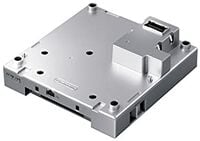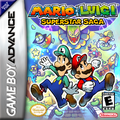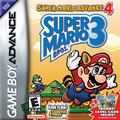Game Boy Player: Difference between revisions
(→Trivia) |
m (Text replacement - "{{([Ss]erials|[Rr]elease)\|" to "{{flag list|") |
||
| (61 intermediate revisions by 26 users not shown) | |||
| Line 1: | Line 1: | ||
[[ | {{system infobox | ||
|image=[[File:GB Player.jpg|280px]]<br>A Game Boy Player<br>[[File:GCN-GBA Cable.jpg|280px]]<br>The cable can serve as a controller for the Game Boy Player. | |||
|generation=Sixth | |||
|release={{flag list|Japan|March 21, 2003|Europe|June 20, 2003|Mexico|June 23, 2003<ref>[https://web.archive.org/web/20030401062006/http://nintendo.com.mx/ Official Mexican Website (Archived)]. Retrieved November 28, 2022.</ref>|USA|June 24, 2003}} | |||
|discontinued=2007 | |||
|predecessor=[[Super Game Boy]] | |||
|successor=N/A | |||
}} | |||
[[File:Game Boy Player logo.svg|175px|left|class=invert-dark]] | |||
[[File:Silver Game Boy Player.jpg|thumb|left|A silver Game Boy Player]] | |||
The '''{{wp|Game Boy Player}}''' is an accessory for the [[Nintendo GameCube]]. As the name implies, it can be used for playing [[Game Boy]], [[Game Boy Color]], and [[Game Boy Advance]] games. It is the successor to the [[Super Nintendo Entertainment System]]'s [[Super Game Boy]], which can play only Game Boy games.<ref group=note>Game Boy Color games that have cross-device Game Boy support can also be played on the Super Game Boy.</ref> | |||
The | The Game Boy Player comes with a special start-up disc that must be inserted into the GameCube before any Game Boy games can be played. The Game Boy Player hooks up to the GameCube by being inserted underneath it and fitting into the GameCube's Hi-Speed Port. | ||
As with all models of Game Boy Advance, the Game Boy Player has a Game Link Cable slot on its front that can be used for multiplayer sessions with Game Boy Advance, [[e-Reader]], or other Game Boy Player devices. | |||
The Game Boy Player | The Game Boy Player does not support using the controller ports as a non-Game Link Cable multiplayer hub for Game Boy Advance devices. | ||
The Game Boy Player | ==Controls== | ||
The Game Boy Player can be played with either a standard GameCube controller or a Game Boy Advance hooked with a Nintendo GameCube–Game Boy Advance Link Cable. | |||
Despite lacking official support for simultaneous multiplayer, the Game Boy Player does support simultaneous input from all four GameCube controller slots. | |||
==Special features in games== | |||
While many GBA games may suffer from intense brightness and/or other minor graphical issues when played on a Game Boy Player, a few games, including two games of the [[Super Mario (franchise)|''Super Mario'' franchise]] (''[[Super Mario Advance 4: Super Mario Bros. 3]]'' and ''[[Mario & Luigi: Superstar Saga]]''), are specially optimized for use on the device, with rumble support for GameCube controllers as well. These games are distinguished by showing the Game Boy Player logo upon booting up, regardless of whether or not the device is being used. | |||
== | In addition, ''[[Mario vs. Donkey Kong]]'' has a manual setting labeled "GB Player Mode," which adjusts the palettes that are better suited for the Game Boy Player. | ||
The Game Boy Player has an option to swap cartridges without having to turn off the GameCube, something that is not possible on any Game Boy series device or on the [[Nintendo DS]]'s Game Boy Advance mode. | |||
{{ | |||
{{ | ==Absent features== | ||
For games released on the original Game Boy, the Game Boy Player plays them in Game Boy Color mode and not Super Game Boy mode. As such, the available selectable palettes are those of the Game Boy Color, and the extended color palettes and/or multiplayer supports in ''[[Picross 2]]'', ''[[Donkey Kong (Game Boy)|Donkey Kong]]'', and ''[[Wario Blast: Featuring Bomberman!]]'' are unavailable. An exception is ''[[Game Boy Camera]]'', which does carry over the video recording support that it had on the Super Game Boy. | |||
There are a few titles that are not made for normal play on the Game Boy Player, such as ''[[WarioWare: Twisted!]]'' and ''[[Yoshi Topsy-Turvy]]'', because they require the player to rotate the entire system around due to the motion sensors on the cartridge, something that the GameCube was not designed to do. The games still boot and run normally, however. | |||
The Game Boy Player is incompatible with the [[Wii]], as it lacks the Hi-Speed Port of the GameCube where it plugs into. Additionally, the Game Boy Player matches the GameCube's footprint, while the Wii has a different footprint placed horizontally. | |||
==''Super Mario'' games with rumble support== | |||
<gallery> | |||
Mario & Luigi Superstar Saga Box NA.png|''[[Mario & Luigi: Superstar Saga]]'' | |||
Super Mario Advance 4 Box.png|''[[Super Mario Advance 4: Super Mario Bros. 3]]'' | |||
</gallery> | |||
===Rumble support in re-releases=== | |||
The two games' rumble support was not available on the [[Wii U]]'s [[Virtual Console]] but was restored in [[Game Boy Advance - Nintendo Switch Online]]. | |||
==Media== | |||
{{media table | |||
|file1=GBA BIOS.oga | |||
|title1=GBA startup screen theme | |||
}} | |||
==Notes== | |||
<references group=note/> | |||
==References== | |||
{{NIWA|Bulbapedia=1|NWiki=1|ZeldaWiki=1}} | |||
<references/> | |||
{{Systems}} | |||
[[Category:Accessories]] | [[Category:Accessories]] | ||
[[it:Game Boy Player]] | |||
Latest revision as of 19:17, September 27, 2024
| Game Boy Player | |
|---|---|
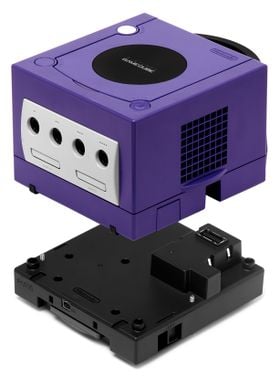 A Game Boy Player 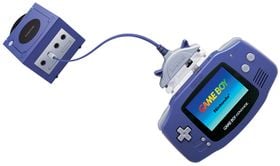 The cable can serve as a controller for the Game Boy Player. | |
| Generation | Sixth generation |
| Release date | |
| Discontinued | 2007 |
| Predecessor | Super Game Boy |
| Successor | N/A |
The Game Boy Player is an accessory for the Nintendo GameCube. As the name implies, it can be used for playing Game Boy, Game Boy Color, and Game Boy Advance games. It is the successor to the Super Nintendo Entertainment System's Super Game Boy, which can play only Game Boy games.[note 1]
The Game Boy Player comes with a special start-up disc that must be inserted into the GameCube before any Game Boy games can be played. The Game Boy Player hooks up to the GameCube by being inserted underneath it and fitting into the GameCube's Hi-Speed Port.
As with all models of Game Boy Advance, the Game Boy Player has a Game Link Cable slot on its front that can be used for multiplayer sessions with Game Boy Advance, e-Reader, or other Game Boy Player devices.
The Game Boy Player does not support using the controller ports as a non-Game Link Cable multiplayer hub for Game Boy Advance devices.
Controls[edit]
The Game Boy Player can be played with either a standard GameCube controller or a Game Boy Advance hooked with a Nintendo GameCube–Game Boy Advance Link Cable.
Despite lacking official support for simultaneous multiplayer, the Game Boy Player does support simultaneous input from all four GameCube controller slots.
Special features in games[edit]
While many GBA games may suffer from intense brightness and/or other minor graphical issues when played on a Game Boy Player, a few games, including two games of the Super Mario franchise (Super Mario Advance 4: Super Mario Bros. 3 and Mario & Luigi: Superstar Saga), are specially optimized for use on the device, with rumble support for GameCube controllers as well. These games are distinguished by showing the Game Boy Player logo upon booting up, regardless of whether or not the device is being used.
In addition, Mario vs. Donkey Kong has a manual setting labeled "GB Player Mode," which adjusts the palettes that are better suited for the Game Boy Player.
The Game Boy Player has an option to swap cartridges without having to turn off the GameCube, something that is not possible on any Game Boy series device or on the Nintendo DS's Game Boy Advance mode.
Absent features[edit]
For games released on the original Game Boy, the Game Boy Player plays them in Game Boy Color mode and not Super Game Boy mode. As such, the available selectable palettes are those of the Game Boy Color, and the extended color palettes and/or multiplayer supports in Picross 2, Donkey Kong, and Wario Blast: Featuring Bomberman! are unavailable. An exception is Game Boy Camera, which does carry over the video recording support that it had on the Super Game Boy.
There are a few titles that are not made for normal play on the Game Boy Player, such as WarioWare: Twisted! and Yoshi Topsy-Turvy, because they require the player to rotate the entire system around due to the motion sensors on the cartridge, something that the GameCube was not designed to do. The games still boot and run normally, however.
The Game Boy Player is incompatible with the Wii, as it lacks the Hi-Speed Port of the GameCube where it plugs into. Additionally, the Game Boy Player matches the GameCube's footprint, while the Wii has a different footprint placed horizontally.
Super Mario games with rumble support[edit]
Rumble support in re-releases[edit]
The two games' rumble support was not available on the Wii U's Virtual Console but was restored in Game Boy Advance - Nintendo Switch Online.
Media[edit]
| File info |
Notes[edit]
- ^ Game Boy Color games that have cross-device Game Boy support can also be played on the Super Game Boy.
References[edit]
- ^ Official Mexican Website (Archived). Retrieved November 28, 2022.
| Video game systems and add-ons | |
|---|---|
| Nintendo home consoles | Family Computer/Nintendo Entertainment System (Family BASIC, Family Computer Disk System) • Super Famicom/Super Nintendo Entertainment System (Satellaview, Super Game Boy) • Nintendo 64 (Nintendo 64DD) • Nintendo GameCube (Game Boy Player) • Wii (Virtual Console, WiiWare) • Wii U (Virtual Console) • Nintendo Switch |
| Nintendo handhelds | Game & Watch • Game Boy • Virtual Boy • Game Boy Color • Game Boy Advance • Nintendo DS (Nintendo DSi, DSiWare) • Nintendo 3DS (Virtual Console) • Nintendo Switch |
| Other | MS-DOS • VS. System • Nintendo PlayChoice-10 • Nintendo Super System • Nelsonic Game Watch • Super Mario Bros. Watch • Gamewatch Boy • Philips CD-i • Mini Classics • Triforce • Visteon Dockable Entertainment System • Classics • LodgeNet • Nintendo Sound Clock: Alarmo |
